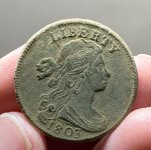pepper
Jr. Member
- Jun 4, 2006
- 28
- 0
Shipwrecks are usually caused or related directly to weather patterns
during a one year cycle. This cycle can be repeated throughout
history at any given interval in 1, 10 or 20 year paterns such as the
circumstances that causes them such as El Nino or La Nino.
When studying certain wreck events such as the 1715 or the 1733
fleet wrecks and noting the time period one may be able to recreate
the direction of the hurricane at that given time period such as the
month and be able to recreate what the possible weather pattern was
at that time of year for hurricanes and what direction the hurricane
came and where it was going.
Therefore, being able to determine the intended direction of the fleet,
where the weather or hurricane was coming from at that time of year,
the scatter pattern of the lead galleon, the ships in between and the
trailing galleon may be a good indication of where to look for the
rest of the fleet or a ship that went down and where the currents
and wind may have taken it based on hurricane wind direction.
I remember Cornelius in a previous thread was trying to express
where the location of ships in a storm that went down may be located
under these circumstances.
Here's a link to a site with an mpeg for the 27 tropical storms and
hurricanes during the year 2005 that can give you insite to this.
http://svs.gsfc.nasa.gov/vis/a000000/a003300/a003354/
All the best!
Pepper
during a one year cycle. This cycle can be repeated throughout
history at any given interval in 1, 10 or 20 year paterns such as the
circumstances that causes them such as El Nino or La Nino.
When studying certain wreck events such as the 1715 or the 1733
fleet wrecks and noting the time period one may be able to recreate
the direction of the hurricane at that given time period such as the
month and be able to recreate what the possible weather pattern was
at that time of year for hurricanes and what direction the hurricane
came and where it was going.
Therefore, being able to determine the intended direction of the fleet,
where the weather or hurricane was coming from at that time of year,
the scatter pattern of the lead galleon, the ships in between and the
trailing galleon may be a good indication of where to look for the
rest of the fleet or a ship that went down and where the currents
and wind may have taken it based on hurricane wind direction.
I remember Cornelius in a previous thread was trying to express
where the location of ships in a storm that went down may be located
under these circumstances.
Here's a link to a site with an mpeg for the 27 tropical storms and
hurricanes during the year 2005 that can give you insite to this.
http://svs.gsfc.nasa.gov/vis/a000000/a003300/a003354/
All the best!
Pepper


 )
)



